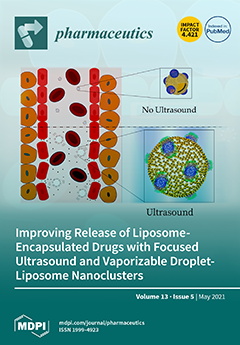A set of copper(I) coordination compounds with general formula [CuBr(PPh
3)(dppz-R)] (dppz-R = dipyrido[3,2-a:2’,3’-c]phenazine (
Cu-1), 11-nitrodipyrido[3,2-a:2’,3’-c]phenazine (
Cu-2), 11-cyanodipyrido[3,2-a:2’,3’-c]phenazine (
Cu-3), dipyrido[3,2-a:2’,3’-c]phenazine-11-phenone (
Cu-4), 11,12-dimethyldipyrido[3,2-a:2’,3’-c]phenazine (
Cu-5)) have been prepared and characterized by elemental analysis,
1
[...] Read more.
A set of copper(I) coordination compounds with general formula [CuBr(PPh
3)(dppz-R)] (dppz-R = dipyrido[3,2-a:2’,3’-c]phenazine (
Cu-1), 11-nitrodipyrido[3,2-a:2’,3’-c]phenazine (
Cu-2), 11-cyanodipyrido[3,2-a:2’,3’-c]phenazine (
Cu-3), dipyrido[3,2-a:2’,3’-c]phenazine-11-phenone (
Cu-4), 11,12-dimethyldipyrido[3,2-a:2’,3’-c]phenazine (
Cu-5)) have been prepared and characterized by elemental analysis,
1H-NMR and
31P-NMR spectroscopies as well as mass spectrometry. The structure of
Cu-1 was confirmed by X-ray crystallography. The effect of incorporating different functional groups on the dppz ligand on the binding into CT-DNA was evaluated by absorption spectroscopy, fluorescence quenching of EtBr-DNA adducts, and viscosity measurements. The functional groups affected the binding modes and hence the strength of binding affinities, as suggested by the changes in the relative viscosity. The differences in the quenching constants (K
sv) obtained from the fluorescence quenching assay highlight the importance of the functional groups in altering the binding sites on the DNA. The molecular docking data support the DNA-binding studies, with the sites and mode of interactions against B-DNA changing with the different functional groups. Evaluation of the anticancer activities of the five copper compounds against two different cancer cell lines (M-14 and MCF-7) indicated the importance of the functional groups on the dppz ligand on the anticancer activities. Among the five copper complexes, the cyano-containing complex (
Cu-3) has the best anticancer activities.
Full article






